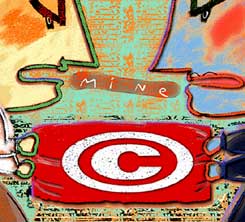Teachers Should Know Copyright From Wrong
Know what you can—and can’t—download for the classroom.
Your content has been saved!
Go to My Saved Content.
As tech-savvy teachers integrate more multimedia work into their classrooms, they also face a thorny question: Who owns the visual, audio, and moving images they download and pop into their presentations? Get the answer wrong, and you may get dinged with a hefty fine.
“I don’t think most teachers willingly ignore copyright issues,” says David Ensign, a professor of law at the University of Louisville, in Kentucky. “But I do think many have the impression that any use of material in education is fair use.”
Fair use is a component of U.S. copyright law that allows limited use of copyrighted material without obtaining written permission, purchasing the work, or paying the creator a royalty. Typically, fair use provides for the legal, non-licensed citation or incorporation of copyrighted material in another author’s work, and applies when they are used for such applications as scholarship or review.
It’s a concept with increasing importance in the modern classroom. Students weaned on tech are demanding more in terms of riveting class material. Consequently, teachers are scouring online sources looking for video and audio clips they can add to presentations—anything to capture and hold their students’ attention.
Seems simple, but there’s a catch. “Fair use in the educational setting is defined more broadly but does not encompass all uses,” warns Ensign.
Fair use in the classroom is often dependent on the subject matter of the content. Ensign says a teacher may not be allowed to show the film The Lion King to the class simply because it was raining and the kids were squirrelly. It could be shown only if the class was doing a study of Disney films or was engaged in the study of a related subject.
Ensign recommends that every school and school district create and enforce a copyright usage policy that is very clear about what is allowable for classroom use. One easy out: linking. Ensign says he doesn’t paste copyrighted material into his lessons and course plans—he links to it. Commenting on a quoted passage, as blogs do, is also fair use.
Yet another approach is provided by Smart Technologies, a company that has teamed up with Cambridge University Press to offer the Global Grid for Learning, which consists of more than a million pieces of copyright-cleared digital information. These include images, video clips, audio files, text documents, and learning objects ready for teachers to incorporate into their lessons.
Before dismissing these options, educators should realize that failure to honor copyrights can cost them personally. “Teachers and librarians don’t realize that although they’re acting on behalf of the school and are not benefiting personally,” Ensign warns, “it doesn’t mean they’re not personally liable.”